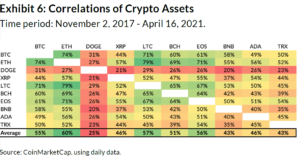Just How to Order Cryptocurrencies: Specialist Tips for Picking the Right Exchange
Just How to Order Cryptocurrencies: Specialist Tips for Picking the Right Exchange
Blog Article
The Future of Cryptocurrencies: Fads to See in the Coming Years
The appearance of Central Financial institution Digital Currencies (CBDCs) stands to redefine the combination of electronic assets within typical monetary systems, while increased governing scrutiny may shape the functional landscape for cryptocurrencies. Additionally, the development of decentralized money (DeFi) and the growing relevance of non-fungible symbols (NFTs) promise to modify perceptions of ownership and appraisal in an electronic economic climate.
Surge of Reserve Bank Digital Currencies
The emergence of Central Financial institution Digital Currencies (CBDCs) represents a considerable change in the economic landscape as governments discover electronic choices to traditional fiat money. These state-backed digital currencies aim to enhance the effectiveness of settlement systems, promote economic incorporation, and give a protected option to private cryptocurrencies. Unlike decentralized electronic currencies, CBDCs operate under the auspices of reserve banks, guaranteeing regulative oversight and security.
Several countries are actively piloting or investigating CBDCs, with noteworthy examples including China's digital yuan and the European Central Bank's digital euro effort. These initiatives highlight a growing acknowledgment of the prospective benefits of digital currencies, such as faster purchase rates and decreased prices connected with cross-border payments. Moreover, CBDCs could function as a device to deal with immoral activities by providing higher transparency in transactions.
As the fostering of CBDCs advances, they may reshape customer habits and impact worldwide financial dynamics. Nonetheless, the transition to a digital money framework provides difficulties, consisting of technical framework, cybersecurity worries, and public depend on. The rise of CBDCs indicates a turning point that can redefine the role of money in a progressively digital economy, calling for close observation by sector stakeholders and policymakers alike.
Enhanced Governing Analysis

Countries around the world are taking different strategies, from outright bans to regulative sandboxes that permit innovation while making certain compliance. The European Union, for instance, is relocating towards extensive regulations with the Markets in copyright-Assets Guideline (MiCA), focused on creating a unified approach throughout member states. In the United States, firms like the SEC and CFTC are significantly energetic in issuing standards and enforcement actions.
This regulative atmosphere is most likely to have significant ramifications for market individuals. Firms running in the copyright room may face stricter conformity needs, which can result in enhanced functional expenses. However, clear policies can also promote greater institutional investment, as companies look for to navigate an extra specified lawful landscape. Eventually, the equilibrium in between advancement and regulation will certainly shape the future of cryptocurrencies.
Evolution of DeFi Platforms
Decentralized Finance (DeFi) systems have undergone considerable improvement since their beginning, reshaping the conventional economic landscape - order cryptocurrencies. These systems largely focused on basic functions such as borrowing and loaning, facilitated by clever contracts on blockchain networks. The evolution of DeFi has actually broadened to encompass a large array of economic services, consisting of derivatives trading, yield farming, and automated market-making.
Among the most notable innovations is the introduction of Layer 2 services, which boost scalability and lower purchase costs, making DeFi extra easily accessible to a wider target market. Furthermore, cross-chain interoperability has actually ended up being an important focus, enabling users to move properties effortlessly throughout different blockchain networks. click here to read This advancement fosters better liquidity and user interaction.
Moreover, the combination of innovative governance versions has actually equipped areas to join decision-making procedures, advertising sustainability and development within the environment. As DeFi remains to develop, we can anticipate more enhancements in individual experience via improved interfaces and protection measures, dealing with worries that have actually previously impeded mainstream fostering. On the whole, the trajectory of DeFi platforms points toward a much more comprehensive and reliable financial future, providing options to traditional financial systems.
Combination of NFTs in Financing
Among the rapid development of the monetary landscape, the assimilation of Non-Fungible Symbols (NFTs) has actually become a transformative pressure. Traditionally related to digital art and collectibles, NFTs are now discovering applications in different economic fields, presenting cutting-edge ways to represent ownership and value.
One significant area of integration is in property, where NFTs can streamline building purchases. By tokenizing property assets, buyers can delight in fractional ownership, reducing entrance barriers and boosting liquidity. order cryptocurrencies. Additionally, NFTs can guarantee clear and unalterable records of possession, improving count on property negotiations
Worldwide of money, NFTs are also being utilized for decentralized financing (DeFi) applications, enabling collateralization of assets. By utilizing NFTs as security, consumers can access finances while maintaining ownership of their digital possessions. This capability enhances the accessibility of economic services and promotes a much more comprehensive monetary ecological community.
Furthermore, the integration of NFTs into typical finance can reinvent the means copyright legal rights are handled, supplying makers with new income streams through smart agreements. Generally, the integration of NFTs in money indicates a change in the direction of even more innovative, reliable, and clear economic services, paving the means for future advancements.
Developments in Blockchain Modern Technology

One significant pattern is the development of Layer 2 solutions, created to enhance scalability and purchase rates, therefore addressing the limitations of primary blockchain networks. These options enable much faster handling of transactions, decreasing fees and enhancing efficiency, which is essential for mass fostering.
Furthermore, interoperability between different blockchain networks is obtaining traction. This development permits smooth data exchange and property transfers throughout diverse platforms, advertising an extra connected and effective ecological community. Protocols that promote cross-chain communication are important for cultivating partnership amongst decentralized applications (copyright) and improving customer experiences.
Furthermore, improvements in consensus systems, such as proof-of-stake and entrusted proof-of-stake, are contributing to even more energy-efficient and safe and secure blockchain operations. These advancements not just address ecological issues yet also improve network durability.
As blockchain innovation proceeds to mature, its integration right into numerous industries, consisting of finance, supply chain, and health care, will certainly redefine traditional systems, leading the way for a decentralized future.
Final Thought
To conclude, the future of cryptocurrencies is characterized by transformative fads that will certainly form the economic landscape. The development of Central Bank Digital Currencies will improve the combination of electronic assets right into traditional financial systems. Concurrently, regulative my latest blog post structures will progress, advertising institutional financial investment while making sure consumer protection. Furthermore, the continual innovation of decentralized money platforms and blockchain technology, alongside the assimilation of non-fungible tokens, will certainly redefine ownership and economic deals, fostering raised adoption and development within the sector.
Report this page